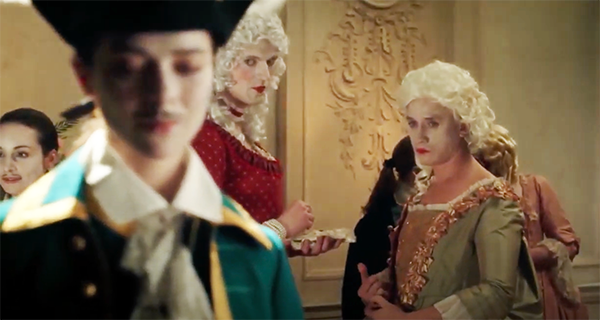Pantyhose, from the miniskirt to the boardroom and now banished to the back of lady’s lingerie drawers.
By Paula Gaikowski, Contributing Editor
I have always been captivated with and loved pantyhose. I hesitated writing this article for fear it would pigeonhole me as being somewhat obsessed in a seedy way. I’ll emphasize that is not the case. It is more that I identify my femininity with this classic sense of style and formality.
Stockings and tights were the first clothes that I was drawn to. They hung from the shower curtain, the girls in my class wore them and television advertisements teased “sheer indulgence.” I remember a No-Nonsense radio ad with a background chorus that sang, “We make you feel more female.”
As I evolved over the years, pantyhose have always been a part of my wardrobe. A close shave and a pair of Hanes Silk Reflection hose will literally transform half my body into a more feminine form. Nowadays, at least once a week when getting dressed for work, I’ll put on my bra, panties and pantyhose sit there for a minute and reflect on the up coming day and take them off before putting on my male work clothes. Nothing sensual or erotic, just a moment of peace.
Pantyhose sales have been in steady decline since the mid 1990’s. What the heck happened? There appears to be a multitude of reasons. As baby boomers entered the workforce, the hippies and counter culture entities shed their blue jeans and peasant skirts for suits, wingtips, pumps and pantyhose. The dress code of business was defined by the current generation in power at the time. Remember the movie
Working Girl with Melanie Griffith. (I wanted to be just like her!)
Then there was a changing of the guard in the mid-90’s Women became managers and gained control over dress codes and fashion choices in business. Female executives began to realize that there was no compelling reason why she or her colleagues had to spend $50 to $100 a month on pantyhose or wear them when it was hot and humid. Sales began a steady decline through the early 2000’s with the financial industry and white shoe law firms being the last holdouts. Today, the only place we see pantyhose daily is on flight attendants and the staff of southern Republican senators.
All is not lost mind you. I travel to the UK several times a year and can tell you unmistakably when women wear a dress, they will wear hose and most often it is black. Perhaps it’s the cool and rainy climate, but the selection of black tights in Marks and Spencer is huge. I can say the same is true in Poland, The Netherlands, Hungary, China and Australia. Argentina and Chile get an honorable mention.
Prior to the advent of pantyhose, stockings were held up by a
garter belt or a girdle with built-in garter clips. An essential part of every woman’s wardrobe, stockings provided the perfect vehicle for DuPont, the company responsible for the invention of nylon. Nylon stockings made their grand debut in a splashy display at the 1939 World’s Fair in New York. By the time stockings were released for sale to the public on May 15, 1940, demand was so high that women flocked to stores by the thousands. Four million pairs sold out in four days.
Pantyhose went on sale in 1959, the year I was born! A coincidence? I think not. Not surprisingly they were invented by a man, Allen Gant in 1953. At the time, Gant ran the Glen Raven Knitting Mill of North Carolina, which was founded by his father John Gant in 1902. Gant was inspired to invent the garment by his pregnant wife, Ethel, who complained about wearing garter belts especially while she was pregnant. It might be worthy to note that Ethel did construct a prototype panty with hose sewn in.
Pantyhose slowly became popular, however, older women were hesitant to give up their stockings and like many trends in the last century, the baby boomers latched onto pantyhose when the miniskirt became popular. Gartered stockings did not work well with miniskirts. Stockings quickly took a back seat and pantyhose became the standard for women. When it was time for them to go to work, the baby boomers brought them into the office and social events.
During their peak of popularity, the selection of pantyhose was overwhelming. They came in all types of colors, deniers of sheerness, textures, support, lite support, control top and sandal foot. There were
television, radio, newspaper and magazines ads.
The sheerness of pantyhose is measured in denier. Denier translates to “French coin of small value.” One very small thread of silk was worth one denier. This evolved into the standard for measuring the thickness of fiber and thread in the modern textile industry.
Super sheer stockings might be 10 or 15 denier, while opaque tights might be
40-60 denier. I’ll note here that in the US, we refer to the more sheer denier as pantyhose and the heavier denier as tights. In the UK, tights are used to describe all pantyhose.
To quote Hosiery Association President Sally Kay, “Sales of the traditional waist high garment will not return to those which the industry experienced in the 1970’s through the late 1990’s.”
Oh, Sally, say it ain’t so!
Fear not my Femulate readers, pantyhose are far from gone. In fact, they are enjoying a small bit of a popularity among younger women. Sheer hosiery had $482 million in sales in the one-year period ending May 2018 and 27% of those sales were to millennials, which is an increase of 9%.
The other 91% were probably me and Stana!
 |
| Wearing Nine West heels |
 |
| Femulating at the 1983 Closet Ball |














































